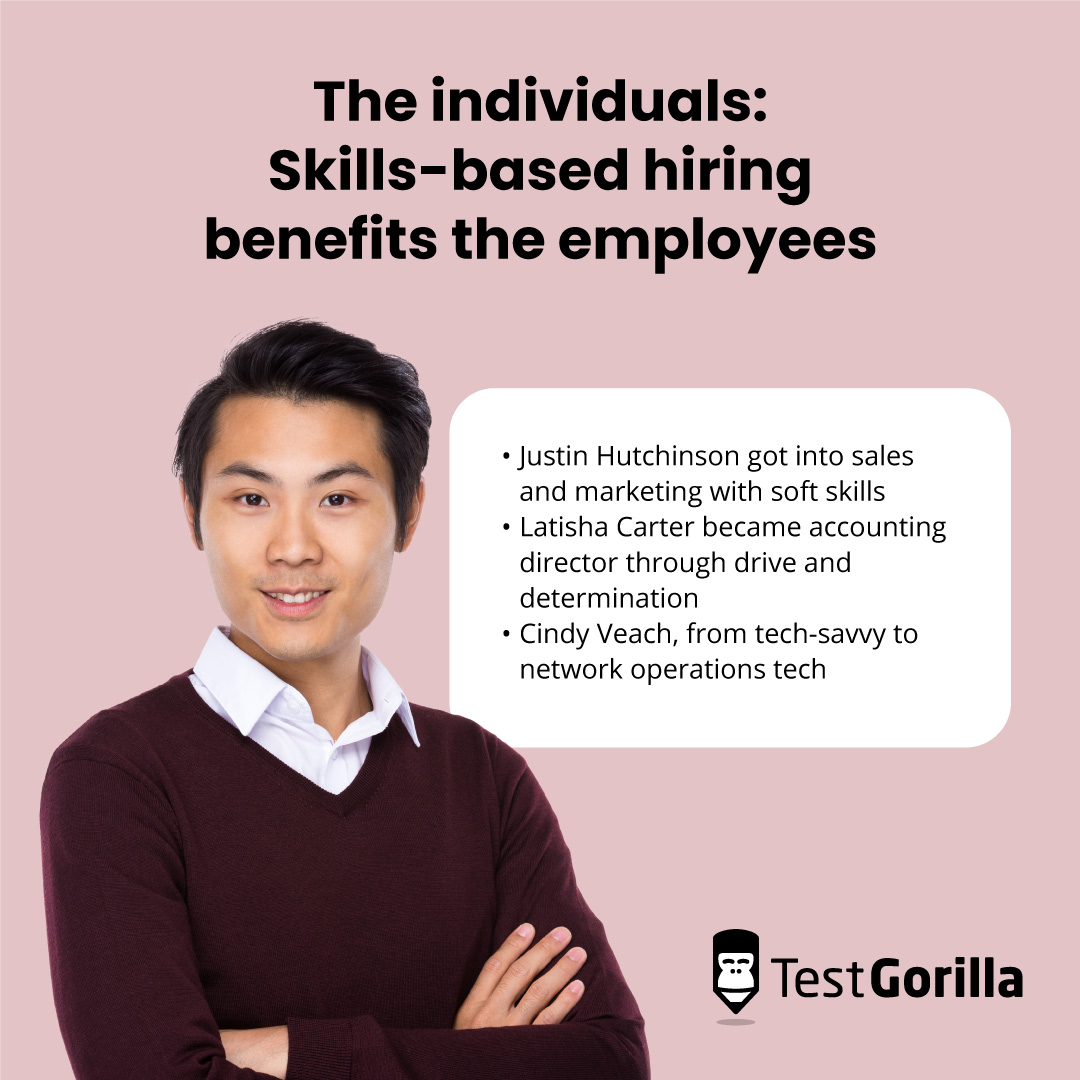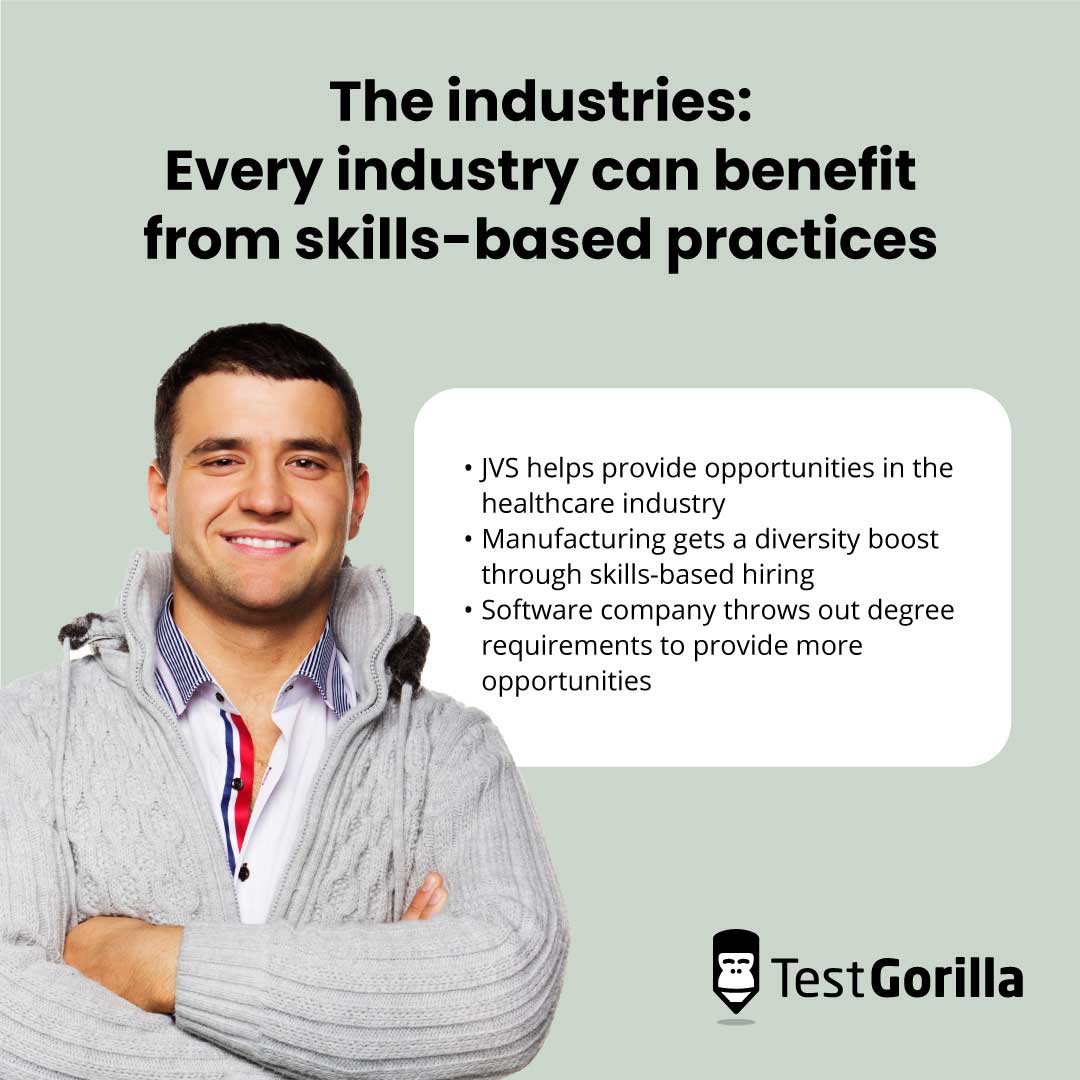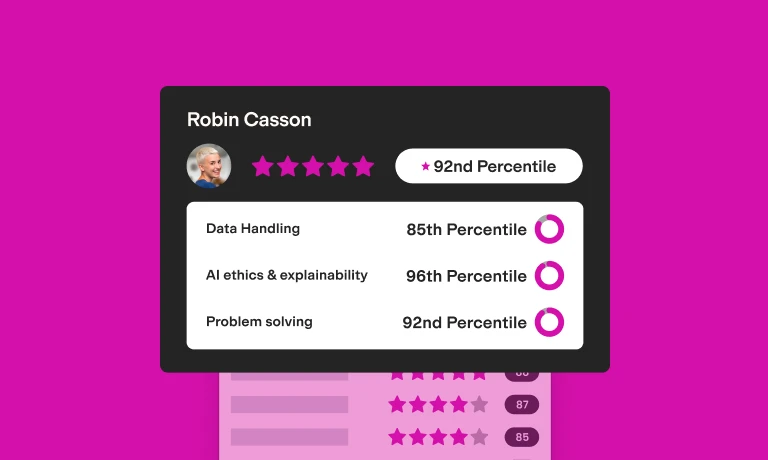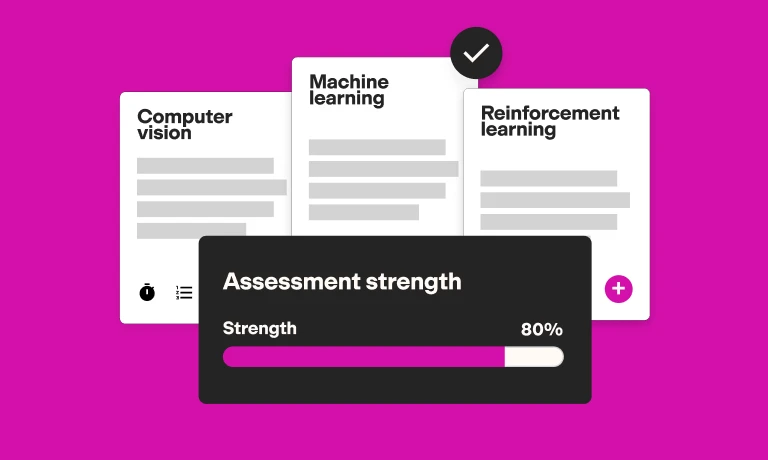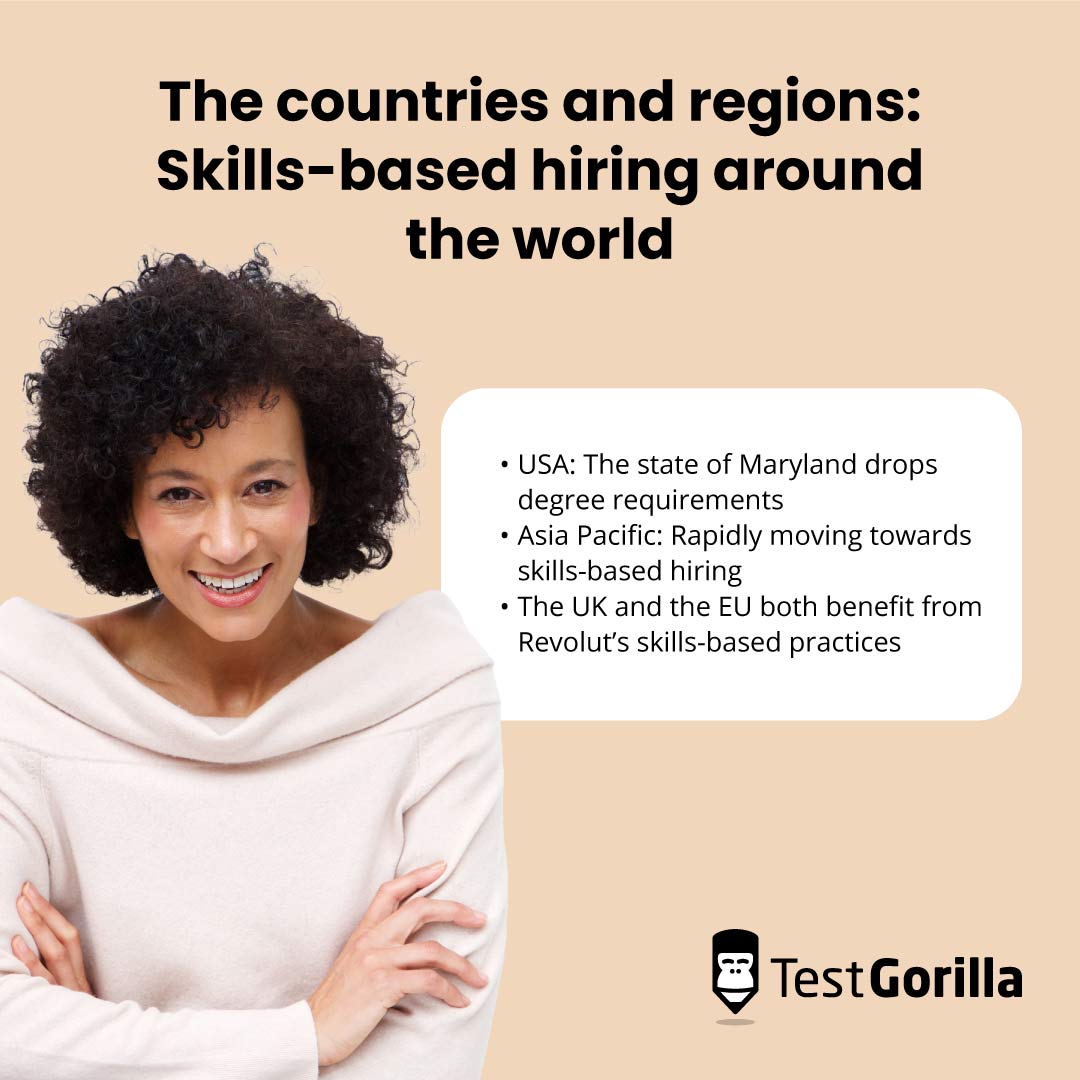Skills-based success: 10 recruiting case studies
The working world has been turned on its head with the pandemic, the Great Reshuffle, and the resulting skills shortage. Companies are searching for a powerful, sustainable way to recruit and retain talent, and 85% of them are now opting for skills-based hiring practices.
Skills-based recruitment practices are for everyone. Don’t believe us? We've put together 10 recruiting case studies that demonstrate how different individuals, industries, and regions have successfully implemented skills-based hiring.
What's the purpose of a recruiting case study?
In recruitment, case studies are helpful tools for employers seeking to build, develop, or optimize their recruitment processes. They can be great sources of information and inspiration. By understanding the successes and failures others have had with their hiring processes, hiring managers can take any relevant learnings without having to make the same mistakes that others have.
To make these recruiting case studies relevant for as many people as possible, we've divided them into personal case studies, case studies by industry, and case studies by region. Let's dive in.
3 personal recruiting case studies
Let’s first look at the personal stories of some stellar individuals who were recruited into their ideal industries using skills-based practices. These people didn’t have traditional backgrounds, but because of their unique skills, they got into amazing roles. All that was needed was a chance to prove those skills during recruitment.
1. Justin Hutchinson
Justin Hutchinson wanted a future in football, but he was faced with a hard choice at age 14: Focus on his career prospects or take care of his father with cancer.
Justin, of course, chose his father and has never regretted that choice, but it did mean giving up the chance of achieving his dream job.
After his father’s passing, Justin attended a community college to fulfill his father’s wish for him to get a degree. To pay rent and living expenses, Justin got a job at a smoothie franchise.
His aim was to simply support his cost of living by making fast food – but it turns out Justin’s real skill was people and communication.
Justin would study the cars that drove up, memorize their orders, and have them ready so he could spend time talking and getting to know the customers instead of making drinks.
One of Justin’s customers was a chief executive of a marketing company and was so impressed with his people skills, he offered Justin an internship.
It wasn’t long before Justin used his soft skills to turn that internship into a full-time position. He dropped out of college, poured his heart and soul into the role, and attained the role of Director of Business Development.
Justin attributes his success to his best skills:
Strategic and critical thinking
Sales management
Justin didn’t have a typical marketing background – his experience was a partial college education with no degree, on-the-job experience (and not a traditionally “relevant” job), and his internship.
Not everyone can find the perfect marketer in a charismatic smoothie server, but online skills testing holds the same principles: Look at abilities first and ask questions later.
Sales and marketing are industries that are uniquely dependent on soft skills, which makes skills-based hiring an obvious choice for recruiting. For information on how it helps with the tricky subject of ramp time, read our article on skills-based hiring and ramp time.
Need more guidance on implementing skills-based hiring?
Read our complete handbook for all the tips, tools, and strategies you need to get the most out of this transformational approach to recruitment.
2. Latisha Carter
Latisha Carter had a dream of excelling in corporate America, but she never got the opportunity to attend college.
At age 17, Latisha became a single mother. This put her dreams of college on hiatus for the foreseeable future.
Three years later, after having another child, Latisha got a job as a nursing assistant. But she still couldn’t shake her desire to make it in the corporate world.
She secured a call center job with NCR, a software company, driven by their offer of extensive employee training.
Offering extensive upskilling and reskilling is one of the best things you can put on the table for potential candidates. A study by Lorman showed that 59% of Millennials believe that development opportunities are extremely important when deciding whether to apply for a position.
Latisha used her experience at NCR to get a role in customer service at the software company Sage.
With determination and hard work, she continued to work her way up for 20 years until she became a director at Xero, an accounting technology company.
Latisha is now proudly a director in corporate America with no college degree. Her company is reaping the benefits of her presence and skills.
In the second half of 2021, Xero’s approach to skills-based hiring and its emphasis on diversity pushed a 7% increase in racial and ethnic diversity.
Jana Galbraith, the executive general manager for people experience partnering for Xero, says: “[H]istorically, hiring based on degree exclusively has perpetuated discrimination.”
This boost is great news for Xero because the benefits of diversity are broad and include increased productivity, innovation, and financial performance.
Latisha’s struggle to succeed is unfortunately common for working mothers. To learn more about this, read our article on the motherhood penalty.
3. Cindy Veach
Cindy Veach didn’t have a traditional background. She had all the tech know-how, but she only had experience involving massage therapy and social services.
But she had the skills and she knew it. Cindy says it was a happenstance that she stumbled upon her perfect role; she just wanted a role where she could use her best talents.
“I was looking for jobs I had the right skills for, organizational skills in particular,” said Cindy.
She happened upon a tech administration apprenticeship program at IBM. Before then, she saw her tech skills as just a hobby and never imagined herself in the tech industry – but she applied and was accepted.
Cindy had a steep learning curve ahead of her. She possessed the base tech skills but needed the training to reach the right level.
She attributes much of her success to the flexibility of her mentors. They continually told her that if a path “didn’t feel right,” she was welcome to experiment and try something new.
At the end of the apprenticeship, she applied for a network operations technician role and was hired. She took a position with flexible work options so she could still care for her two children comfortably.
Skills-based hiring made this outcome possible. Cindy’s communication skills, digital expertise, and problem-solving abilities helped her secure her role, and the focus on continuous improvement is helping her develop it.
She says that the combination of her appetite for learning and her employer’s support for her success is the perfect duo for creating limitless growth.
The best insights on HR and recruitment, delivered to your inbox.
Biweekly updates. No spam. Unsubscribe any time.
3 recruiting case studies by industry
We’ve heard plenty of people say “skills-based hiring doesn’t work in my industry.” But that’s just yet another myth we’ve debunked. Let’s take a look at a handful of case studies about how companies within certain industries have succeeded with skills-based recruitment initiatives.
4. Healthcare
Healthcare administration is an industry that’s notoriously difficult to get into. Between receiving a bachelor’s degree and completing a master’s program, it can take six to eight years of rigorous commitment.
However, more opportunities are arising that allow equally qualified candidates to get in without obtaining specific educational requirements.
Sam Saucedo-Hernandez had a tumultuous life, but she only ever wanted a solid career. As a child of parents who emigrated from Mexico, she wanted to be the first generation in her family to attain a degree.
Sam watched her parents struggle with low-wage jobs and promised herself she would do better for herself.
Her first attempt was at law school where she spent several years studying hard. Sam was ecstatic to get her degree and begin a career in law.
But two weeks after she got her associate of science degree, the school got shut down for fraud, leaving Sam jobless and $60,000 in debt.
Sam faced many challenges, but the turning point in her story was the day she received a letter promoting a no-cost medical administrative assistant job training program from JVS.
JVS is a program that helps people build skills and find solid career connections – particularly in the healthcare industry.[1]
JVS has seen amazing success with over 500 employer partners and an emphasis on promoting diversity: 88% of their participants are Black, Hispanic, Asian, or a wide range of other ethnicities.
Sam applied for the program and was accepted. She secured a position as a medical administrative assistant, but her training has led her to her current role in the audiology department.
Though she’s fortunate for her position, Sam says she’s still looking forward, wondering where her skills can take her from here.
Programs like JVS are working tirelessly to make more stories like this possible. With a focus on skills over experience, they bring in valuable candidates to industries that may otherwise be restricted to them.
5. Manufacturing
Steelcase, a furniture manufacturing company, wanted to build a fairer place for employment opportunities and encourage better representation for employees of color. So they adopted skills-based hiring practices.
They’re far from the only ones. According to TestGorilla’s State of Skills-Based Hiring report, 83% of businesses say increasing diversity is important to them in 2025.
And companies are succeeding at this by implementing skills-based hiring: 91% of organizations saw an increase in diversity due to skills-based hiring.
Steelcase realized that if they truly wanted to boost their DE&I initiatives, traditional hiring methods wouldn’t do.
They decided their hiring processes needed to be revamped for the better, so they adopted some new practices:
Prioritizing skills over resume and pedigree
Removing experience requirements wherever possible
Favoring continuous improvement over perfection
Revamping job descriptions to reduce biased language
Prioritizing diversity among equally qualified candidates
Steelcase decided that practices like these would enable them to reach diverse talent organically, and it worked. Since the program started, Steelcase’s new hires are 55% women and 30% racial or ethnic minorities.
Steelcase’s initiatives are amazing, so we encourage similar active moves to boost diversity. To read more about this topic, read our blog on why being intentional about workplace diversity is non-negotiable.
6. Software
ADP, an HR management software company, adopted a recruiting strategy to focus on skills, rely less on credentials, and make an effort to provide opportunities for candidates with nontraditional backgrounds.
This strategy included training talent acquisition professionals on best practices, hiring specific diversity recruiters, removing degree requirements from high-volume recruiting roles, and leveraging better training and mentorship for new hires.
What were the results? ADP saw great success in one year:
An increase in the number of candidates with no college degree
An increase in Black representation in the candidate pool
An increase in Hispanic representation in the candidate pool
This program was heavily inspired and backed by Maria Black, the chief executive of ADP, and her strong belief in corporate social responsibility.
She has a strong passion for supporting working women, veterans, and other underrepresented talents.[2]
Maria is an excellent example of the power of leading from the top. When your company’s leadership supports a great cause, it benefits both employees and company alike and builds a better organizational culture.
4 recruiting case studies by region
Next, let’s take a look at some case studies about the regions and countries that are taking on skills-based recruitment practices. For more on this subject, check out our post on skills-based hiring around the world.
7. Maryland, USA
In 2022, the state of Maryland dropped four-year degree requirements for thousands of jobs in the government sector.
The aim of this initiative was to draw attention to the value of alternative credentials and experience. State officials want to give people a better shot at securing a stable, fulfilling job.
Governor Larry Hogan was quoted as saying:
“[W]e are ensuring qualified, non-degree candidates are regularly being considered for these career-changing opportunities.”[3]
Over 38,000 people work for the state of Maryland and it’s estimated that more than half of those jobs can be performed by people whose alternative skill routes can easily substitute for a college education.
These alternative routes include:
Life experience
Non-relevant job experience
Hobbies and volunteer work
Alternative training
Community college education
Maryland estimates that about 47% of its working population are STARs (skilled through alternative routes). That’s 2.8 million workers, and these people need solid opportunities – opportunities that they can access through skills-based hiring.
To learn more about how unnecessary degree requirements are holding top talent back, read our blog on degree inflation.
8. Indiana, USA
Indiana’s tech leaders are struggling to attract and retain great talent. They’re facing a major skill shortage and they can’t solve it with the “usual” hiring methods.
Traditional recruiting methods exclude over 95% of Indiana’s workforce.
Indiana has a workforce of 3,332,239 people, but consider this:
A four-year degree requirement removes 75%
Biases can eliminate up to 30% of the pool
Requiring specific past experience removes 93% of the talent pool
With all of that in mind, a pool of more than three million candidates is reduced to just over 42,000.
Indiana’s Office of Technology (IOT) realized that skills-based hiring practices could fix this problem and solve their shortage.
They started by removing degree requirements from most job descriptions, then took the next step and started offering reskilling opportunities to workers from alternative industries, such as line cooks and truck drivers.
Tracy Barnes, IOT’s chief information officer, said that the results of the program have been positive and they’re “very pleased” so far. She also said that she’s equally excited to see the positive life impacts for the candidates involved.
9. Asia-Pacific
Skills-based hiring is quickly gaining traction in the Asia-Pacific area.
One study showed that 79% of businesses in the Asia-Pacific area look for skills when hiring versus the 21% that prioritize education and experience.[4]
The same study found that internal mobility is more important than ever and that companies want to prioritize gender equality and disability inclusion. These points can also be accomplished by adopting skills-based hiring.
Asia-Pacific is looking to skills-based practices to improve the future of their recruitment processes, but Singapore-based TruTrip is already reaping the benefits.
TruTrip is a business travel management company that needed help assessing candidate skills and hiring the best candidates, so they gave TestGorilla a try.
Here are a few ways that TestGorilla’s pre-employment skills testing helped TruTrip’s recruitment processes:
Gives them a way to objectively assess applicants’ skills and knowledge
Helps them eliminate bias from the hiring process
Enables them to consistently make better hiring decisions
Reduces their reliance on resume screening
Enhances teamwork and communication
Improves the employee experience of new hires
According to Hugh Batley, the founder of TruTrip, their new hires are a better fit. These employees become great contributors and have a better initial experience with the company.
TestGorilla also helps TruTrip save thousands of dollars by reducing the chances of a costly mis-hire.
This isn’t unusual. According to TestGorilla’s 2024 State of Skills-Based Hiring report, 90% of organizations using skills-based practices saw a reduction in mis-hires in 2024. TestGorilla's 2025 report on skills-based hiring found that skills-based employers are far more satisfied with their hires on average.
10. The UK and the EU
The UK and the EU have developed a strong focus on skills over the past few years.
Interest in skills-based hiring in the UK rose 63% from 2021 to 2022. This drastic increase is due to employers wanting a wider talent pool and candidates prioritizing and valuing their alternative experience.
This move is helping job opportunities reach the 73.6% of people in the United Kingdom who don’t possess a four-year degree.[5]
As for the European Union, they developed the “Pact For Skills” program in 2020. This program was created to encourage and fund better upskilling and reskilling while also promoting greater diversity and gender equality.[6]
A good example from both areas is the British-Lithuanian bank, Revolut.
Revolut adopted skills-based hiring by using TestGorilla’s skills tests and, as a result, improved their time-to-hire by 40%.
Among many other benefits, Revolut found TestGorilla’s language tests life-saving. Assessing language proficiency is essential for a multinational company, but traditional methods are time-consuming and laborious.
TestGorilla’s language tests help Revolut to quickly and easily evaluate their candidates’ reading, writing, listening, and speaking skills. This helped them to nearly fully automate their screening process, improving time-to-hire greatly.
Looking for more recruiting case studies?
To read more case studies and success stories about skills-based hiring, check out our 10 stories that demonstrate the power of skills-based hiring or our collection of customer case studies.
Here are 3 top picks from our case studies:
Design Pickle uses TestGorilla to boost application completion rate by 25%
TestGorilla helps TruTrip to save money and improve employee experience
If you’d like to acquaint yourself with a solid skills-based hiring practice, browse our test library and review our skills tests.
Sources
“JVS 2022 Impact Report”. (2022). JVS. Retrieved March 6, 2023. https://impact2022.jvs.org/
“Maria Black, president and CEO”. (n.d). Business Roundtable. Retrieved March 6, 2023. https://www.businessroundtable.org/about-us/members/maria-black-president-and-ceo-adp
McGraw, Mark. (April 4, 2022). “Dropping Degree Requirements: Do Employers Still Care About Education?”. World at Work. Retrieved March 6, 2023. https://worldatwork.org/resources/publications/workspan-daily/dropping-degree-requirements-do-employers-still-care-about-education
“The Future of Talent”. (2021). LinkedIn. Retrieved March 6, 2023. https://business.linkedin.com/content/dam/me/business/en-us/talent-solutions/resources/pdfs/future-of-talent-whitepaper.pdf
“Overview of the education system”. (2022). Education GPS. Retrieved March 6, 2023. https://gpseducation.oecd.org/CountryProfile?primaryCountry=GBR&treshold=10&topic=EO
“Pact for Skills”. (November 10, 2020). European Commission. Retrieved March 6, 2023. https://ec.europa.eu/social/main.jsp?catId=1517&langId=en
You've scrolled this far
Why not try TestGorilla for free, and see what happens when you put skills first.


